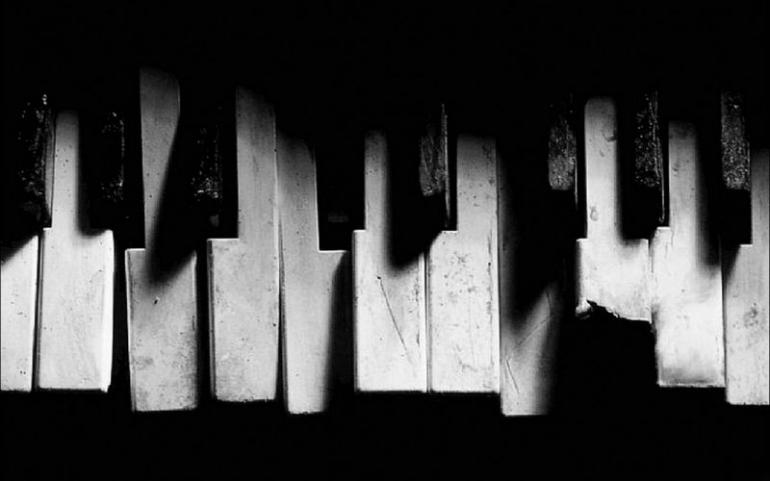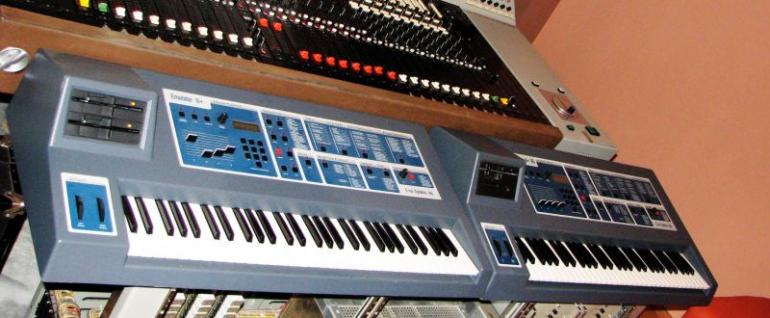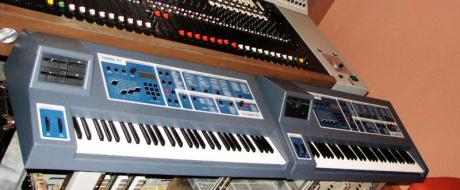Rockové klávesy - Emulace dechových nástrojů, část 3
Wind-Blown: Emulating flute and brass sounds
Welcome readers to another installment of Rock Keyboards! This is part three of our article on emulating wind-blown instruments on synthesizers. In the first two parts, we spoke about synth hero, Vangelis, and techniques for getting a synth to sound like a saxophone and harmonica. In part three we will speak about making keyboards sound like flutes and brass instruments.

Emulation of flute sounds with The Beatles
Possibly the earliest instance of a synthesizer emulating the sound of a flute was the Mellotron. Introduced in 1963, the instrument functioned much like our modern samplers. Instead of digital information, however, the Mellotron used tape loops that would spin over a magnetic head when a key was struck. In 1966 the Beatles obtained the instrument and used it on the intro of Strawberry Fields Forever. Author Mark Cunningham has called the flute part “probably the most famous Mellotron figure of all-time”. Here is a great video link of Paul McCartney speaking about the instrument and then playing the famous intro:

Another flute from Japan
There is one more uses of synth flute that I wanted to mention. Peter Gabriel released an amazing album in 1986 called So. The lead single, Sledgehammer, had an ethereal synth flute sound patterned after the shakuhachi, a long Japanese bamboo flute. The synth used was the iconic Emulator 2; a highly respected unit with a hefty price tag of US $8000. The synth had an uncommonly high sample rate and an analog audio output stage that featured four pole low pass resonant filters. Experts agree that these features added to the magical warmth of the sounds. Here’s a clip of the Emulator 2 in action:
http://www.synthmania.com/Famous%20Sounds/Sledgehammer.mp3
The birth of brass synth
The music world was changed forever in 1980 with the release of Tom Oberheim’s OB-Xa. The synth had significant upgrades from the original OB-X with the use of the very stable Curtis chips which contributed to the great filters and aggressive sound of the keyboard. Van Halen used Oberheim synths on the hit single from 1984, Jump. Swedish rock band, Europe, also used an Oberheim brass patch for the lead riff on their biggest hit, The Final Countdown.
Here's a video of Van Halen's Jump:
https://www.synthtopia.com/content/2009/06/30/van-halen-jump-demo-oberheim-obx-a
Orchestral trumpet sounds
Synth emulations of orchestral trumpet sounds are a little less common because, to be honest, they tend to sound much less authentic than the other instruments we've talked about. I came across a great video link of someone programming a real trumpet sound, however, and wanted to share it with you. In general, start with a saw wave, offset the attack just a little to simulate a blown sound, and use some gentle LFO to add a little waver just as if a person was breathing into the sound. Here’s the video link:
https://www.youtube.com/watch?v=z65DSP5jw8k
4pole filter: Filtr, tedy jakýsi jednopásmový ekvalizér, který ořeže vše nadurčitou frekvencí (low-pass) nebo pod ní (high-pass) nefunguje tak, že by setyto utlumené frekvence neozvaly vůbec. Ubývají postupně – čím vyšší kmitočet,tím méně je slyšet. Záleží na tom, jak je filtr takzvaně strmý, což sevyjadřuje v decibelech na oktávu, přičemž vůči danému kmitočtu je vyšší oktávadefinována jako dvojnásobná frekvence, nižší pak jako poloviční. Pokud má filtrstrmost 6 dB/okt., někdy jej označujeme za filtr 1. řádu (1 pole filter).Analogicky je pak „2 pole filter“ 12 db/okt. a konečně „4 pole“ 24db/okt.
Resonant filter:Rezonantní filtr je takový, u kterého se v bodě začátku ořezu (cutofffrequency) utvoří jakési „vyboulení“, tedy než začne útlum, těsně před tím vúzkém pásmu naopak dojde k nárůstu. Analogové pasivní filtry (např. běžnátónová clona na kytaře či baskytaře) to bez rezonance ani „neumějí“. U filtruna syntezátoru ale často můžeme míru rezonance filtru nastavit, čímž získámeneuvěřitelně širokou škálu zvuků za pomocí velice jednoduchého obvodu.
Curtis chips: Integrovanéobvody vyvinuté jednou z firem Douga Curtise se objevily v tolika slavných (iméně známých) syntezátorech, že by se mohlo zdát, že šlo téměř o monopol. KroměOberheimu to byly například některé modely syntezátorů Ensoniq, Fairlight,Doepfer, E-mu, Waldorf, Moog, Akai, Roland, Korg a další. Když vypršelaplatnost patentů, některé firmy tyto čipy začaly kopírovat. Nedávno vzbudilrozruch veřejný výrok zástupců firmy Behringer, že se chytají vyrábět kopietěchto obvodů.
Offset the attack:V kontextu tohoto článku to znamená o něco zpomalit náběh tónu. Každý akustickýnástroj potřebuje několik milisekund, než se rozezní. Pokud se snažíme nasyntezátoru napodobit právě takový nástroj, je dobré nenechat zvuk znít v plnésíle od samého začátku, a to i v případech, že náběh tónu simulovaného nástrojeje velmi rychlý – z principu věci totiž nemůže být okamžitý.




